How Big Is a Sheet Pan
Sheet pans come in various sizes to suit different cooking needs. The most common dimensions you'll encounter are 26 x 18 inches for a full-size sheet pan, 18 x 13 inches for a half sheet, and 13 x 9 inches for a quarter sheet. Full-size pans are typically used in commercial kitchens, while half and quarter sheets are more suitable for home use. European sheet pans follow different standards, with full-size GN pans measuring approximately 21 x 13 inches. When choosing a sheet pan, consider your oven size, cooking habits, and the types of dishes you'll prepare. Understanding these dimensions will help you select the right pan for your culinary adventures.
This post may contain affiliate links. If you make a purchase through these links, I may earn a commission at no additional cost to you. Additionally, portions of this post may be generated using artificial intelligence (AI) technology. While we strive for accuracy, please be aware that AI-generated content may not always be perfect and should be fact-checked when necessary.
The Spatula Scoops
- A full-size sheet pan measures 26 x 18 inches, commonly used in commercial kitchens.
- Half sheet pans, ideal for home use, are 18 x 13 inches and fit standard ovens.
- Quarter sheet pans measure 13 x 9 inches, suitable for smaller tasks and toaster ovens.
- Jelly roll pans typically measure 15.5 x 10.5 inches, designed for thin cakes and bar cookies.
- European full-size sheet pans (Gastronorm) are approximately 21 x 13 inches or 530mm x 325mm.
Standard Sheet Pan Dimensions
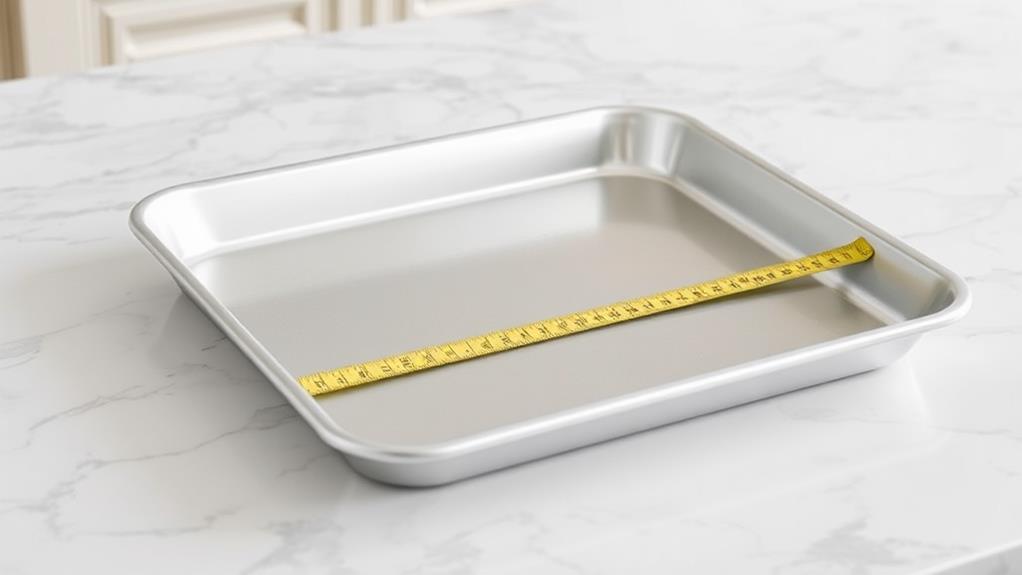
When it comes to sheet pans, size matters. You'll find that sheet pan sizes come in four standard dimensions, each serving a specific purpose in the kitchen. Let's break them down for you.
The full-size sheet pan, measuring 26 x 18 inches, is the largest option. It's primarily used in commercial kitchens due to its capacity to handle large volumes of food. Next up are half sheet pans, which measure 18 x 13 inches. These versatile pans are perfect for home use, as you can fit two of them side by side in a standard oven.
For smaller tasks, you've got quarter sheet pans. At 13 x 9 inches, they're ideal for cooking smaller batches and can even fit in most toaster ovens. Finally, there's the eighth-size sheet pan, measuring 6.5 x 9.5 inches. This compact size is great for oven-to-table serving and small baking tasks.
Understanding these standard sheet pan dimensions will help you choose the right size for your cooking needs. Whether you're batch cooking for a crowd or preparing a small side dish, there's a sheet pan size that's perfect for the job.
Full-Size Sheet Pan Specifications
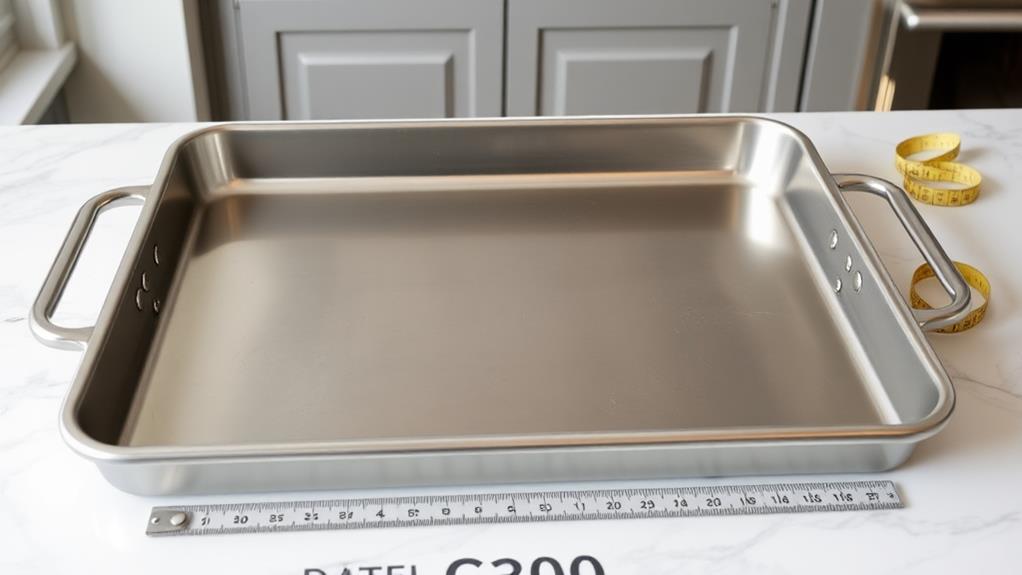
For professional chefs and large-scale catering operations, the full-size sheet pan reigns supreme. These baking sheets boast impressive pan dimensions, measuring 26 inches long by 18 inches wide. This generous size provides ample space for oven cooking, allowing you to prepare large quantities of food in one go.
When you're working in commercial kitchens, you'll appreciate the full sheet pan's 1-inch high sides. These raised edges help contain liquids and prevent spills during cooking, ensuring a cleaner and safer work environment. The pan's construction is typically heavy-gauge aluminum or stainless steel, which promotes even heat distribution and durability.
Here are some key features of full-size sheet pans:
- Large surface area for maximum cooking capacity
- 1-inch high sides for spill prevention
- Durable materials for long-lasting use
- Ideal for commercial kitchens and catering
While full-size sheet pans are perfect for professional settings, they're often too large for home ovens. Their dimensions make them impractical for most residential kitchens. However, if you have the space and need to cook in large quantities, a full-size sheet pan can be an invaluable tool in your culinary arsenal.
Half and Quarter Sheet Sizes
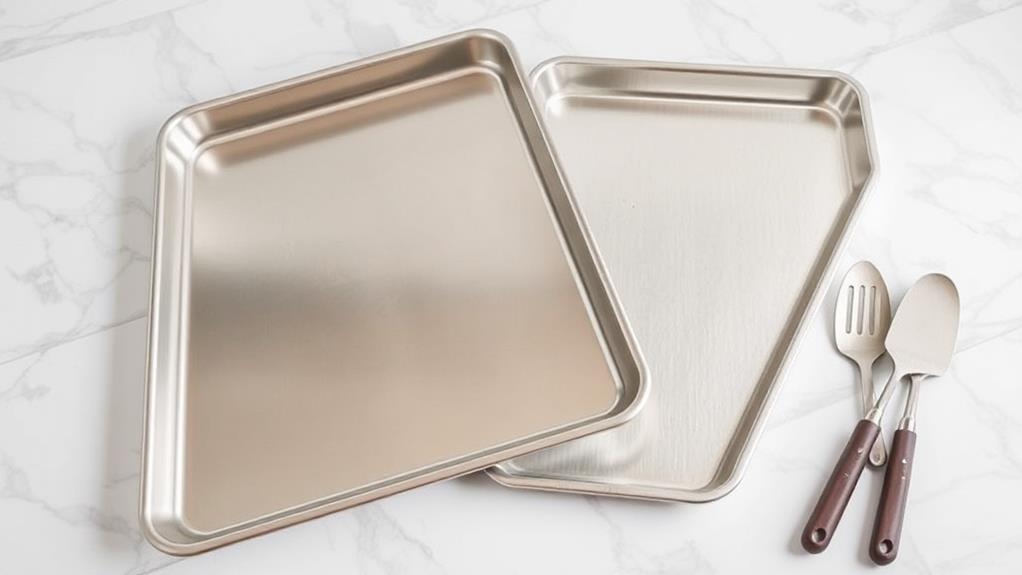
Home cooks' go-to sheet pans are typically half and quarter sizes, which fit comfortably in standard residential ovens. Half sheet pans, measuring 18 by 13 inches, are versatile workhorses in your kitchen. You'll find them perfect for baking cookies, roasting vegetables, or preparing sheet-pan dinners. Their 1-inch high sides contain liquids and juices, making them ideal for various cooking tasks. For non-stick baking needs, consider using non-stick parchment paper, which can help prevent sticking and make cleanup a breeze.
Quarter sheet pans, on the other hand, are smaller at 13 by 9 inches. They're great for baking single-layer cakes or using in toaster ovens. Keep in mind that dimensions can vary slightly by vendor, sometimes listed as 9.5 by 13 inches, so always check specific measurements before purchasing.
When it comes to oven efficiency, half sheet pans allow you to fit two per standard shelf, perfect for batch cooking. Quarter sheets are better suited for smaller servings or limited oven space. Both sizes offer the versatility you need in the kitchen, whether you're baking a batch of cookies or preparing a quick dinner. Understanding these baking sheet sizes will help you choose the right cookie sheets for your cooking needs.
European Sheet Pan Measurements
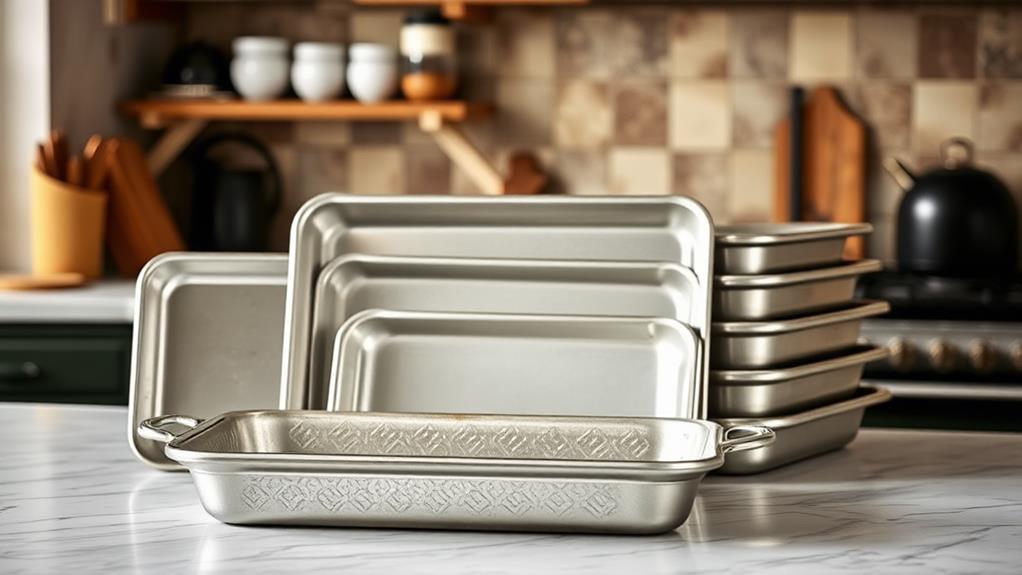
When you're exploring sheet pan sizes, you'll find that European measurements differ from their American counterparts. European baking trays follow standardized dimensions set by the European Committee for Standardization, using metric measurements instead of imperial units. These standardized sizes, known as Gastronorm (GN) numbers, guarantee compatibility across various kitchen equipment and provide consistency for bakeries and restaurants throughout Europe.
Standard European Sizes
European kitchens follow a standardized system for sheet pan sizes, known as Gastronorm (GN). This system guarantees compatibility across various kitchen equipment and provides consistent baking results. The standard commercial full-size GN sheet pan measures 530mm x 325mm, which is roughly 21in x 13in. This size is ideal for high-volume baking and is widely used in professional kitchens.
European baking trays come in a range of depths to accommodate different baking needs. You'll find common depths of:
- 20mm
- 40mm
- 65mm
- 100mm
These varied depths allow you to choose the right pan for your specific recipe, whether you're baking cookies or roasting vegetables. It's essential to realize that while these sizes are standardized, slight variations may occur between manufacturers. Always double-check the exact dimensions when purchasing new sheet pans to verify they'll fit your oven and other kitchen equipment.
The GN system also includes fractional sizes, such as half-size and quarter-size pans, which are proportionally smaller than the full-size sheet. These smaller sizes offer flexibility in commercial kitchens and are useful for preparing smaller batches or different dishes simultaneously.
Metric vs. Imperial Measurements
Understanding the difference between metric and imperial measurements is essential when dealing with European sheet pans. When you're working with European baking equipment, you'll encounter metric measurements exclusively. The standard full-size European sheet pan measures 600mm x 400mm, which translates to approximately 23.6 inches x 15.7 inches in imperial units. It's imperative to be aware of these conversions to guarantee compatibility with your kitchen equipment and recipes.
European pan sizes are standardized under EN 631, using the Gastronorm (GN) system. This standardization extends to pan depths, which range from 20mm to 200mm. You'll find that two-thirds and half-size pans are also common, measuring 530mm x 325mm and 400mm x 300mm, respectively.
The metric system's precision allows for consistent baking results across different commercial kitchens in Europe. When adapting recipes or purchasing equipment, you'll need to convert between metric and imperial measurements carefully. Remember that 1 inch equals 25.4mm, and 1mm is about 0.039 inches. By familiarizing yourself with these conversions, you'll be better equipped to work with European sheet pans and achieve accurate baking results.
Specialty Sheet Pan Variations
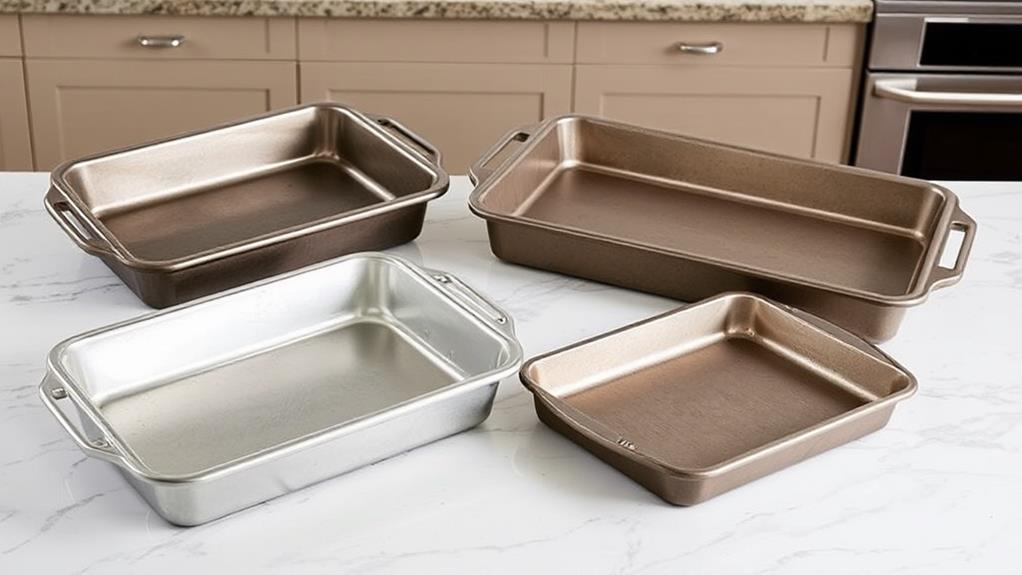
You'll find that specialty sheet pans come in various sizes and designs to suit specific baking needs. Jelly roll pans, typically measuring 15.5 by 10.5 inches, feature raised edges to prevent spills and are perfect for thin cakes. Cookie sheets, on the other hand, often have one or more open sides for easy sliding, while insulated sheet pans use a double-layer construction to distribute heat evenly and prevent burning.
Jelly Roll Pan Dimensions
Bakers and dessert enthusiasts often turn to the jelly roll pan for specialized recipes. This versatile baking pan has specific dimensions that set it apart from other sheet pans. Typically measuring 15.5 by 10.5 inches, it's larger than a quarter sheet but smaller than a half sheet. The jelly roll pan's unique features include one-inch-deep sides and raised edges, which are essential for containing batters and preventing spills.
When you're working with a jelly roll pan, you'll find it's designed for particular baking needs:
- Creating jelly rolls or Swiss rolls
- Baking bar-type cookies
- Preparing thin sheet cakes
- Roasting vegetables in a single layer
The pan's dimensions are carefully calculated to guarantee successful results for these specific recipes. While it's not easily replaceable, you can use a jelly roll pan similarly to a quarter-sheet pan for various desserts. The slightly larger surface area gives you more flexibility in your baking projects.
Understanding the dimensions and purpose of a jelly roll pan will help you choose the right baking equipment for your recipes, ensuring excellent results in your culinary endeavors.
Cookie Sheet Design Features
Cookie sheets stand out among sheet pans with their unique design features tailored for ideal baking results. Unlike standard baking sheets, you'll find that cookie sheets typically lack raised sides, promoting better air circulation for even cookie baking. This design is essential when you're aiming for perfectly baked goods.
When selecting a cookie sheet, you'll encounter various materials and features:
| Material | Benefits | Best For |
|---|---|---|
| Aluminum | Lightweight, conducts heat well | General baking |
| Aluminized steel | Durable, resists warping | High-temperature baking |
| Insulated | Prevents over-browning | Delicate cookies |
| Non-stick | Easy release, simple cleanup | Sticky doughs |
The size of your cookie sheet can vary, typically ranging from 9×13 inches to 18×26 inches. This variety allows you to choose the right size sheet pan for your baking needs. You'll notice that most cookie sheets feature a small lip on one edge, making them easy to handle when transferring in and out of the oven. When shopping for cookie sheets, consider your baking preferences and the types of cookies you'll be making most often to select the best option for your kitchen.
Insulated Sheet Pan Benefits
Exploring the world of specialty sheet pans reveals the unique benefits of insulated varieties. These pans feature a double-layer design with air sandwiched between, offering superior heat retention and distribution. You'll find that insulated sheet pans are particularly useful for delicate baked goods that require precise temperature control.
When you're baking with an insulated sheet pan, you'll notice:
- More even baking across your treats
- Reduced risk of burnt bottoms on cookies and pastries
- Longer baking times without increasing temperature
- Enhanced durability due to thicker edges that resist warping
The design of insulated sheet pans allows for gentle, uniform heat distribution. This means you can achieve consistent results with your baked goods, especially when working with recipes that need a steady, controlled bake. The air barrier between the metal layers acts as insulation, preventing hot spots and promoting even browning.
You'll appreciate the versatility of these pans, as they come in standard sizes like half sheets and quarter sheets. Their durability makes them a favorite in both home and commercial kitchens, where they can withstand frequent use without compromising performance.
Choosing the Right Sheet Size
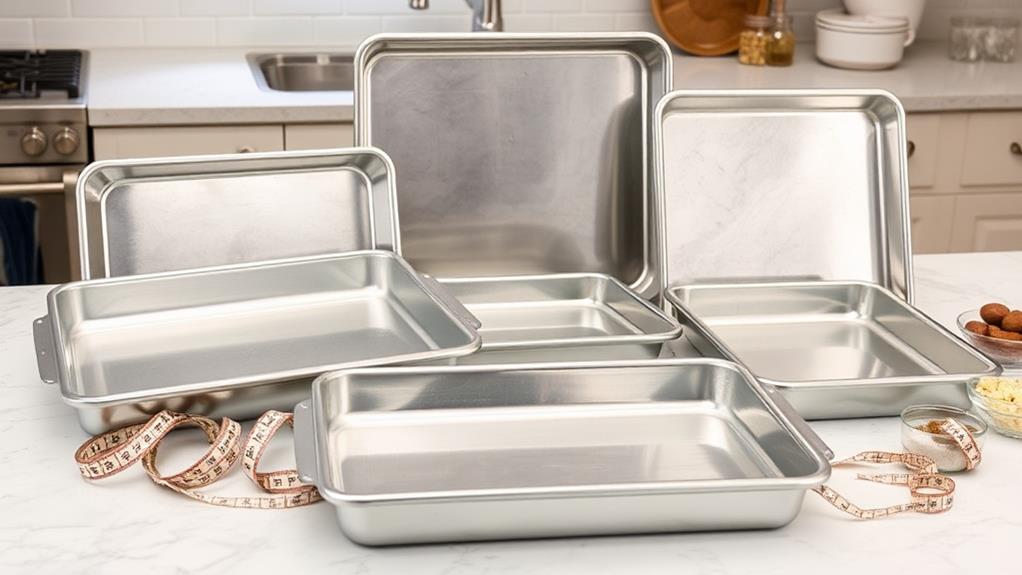
When selecting the right sheet pan size, you'll need to take into account both your oven's capacity and your cooking needs. Sheet pans come in five standard sizes, ranging from full to 1/8 size. However, for most home cooks, the half sheet size (18×13 inches) is a versatile choice that fits well in standard ovens and accommodates various recipes.
If you're cooking for one or using a toaster oven, quarter sheet pans (13×9 inches) might be more suitable. These smaller pans are perfect for single servings and take up less space. Keep in mind that larger pans, like the full size (26×18 inches), may not fit in your home oven.
To choose the right size, consider what you'll be cooking most often. If you frequently bake cookies or roast vegetables, a half sheet size will likely meet your needs. For smaller tasks or limited oven space, quarter sheet pans are an excellent option. By understanding the dimensions and how they align with your cooking habits, you'll guarantee superior results and convenience in your kitchen.
Sheet Pan Materials and Durability
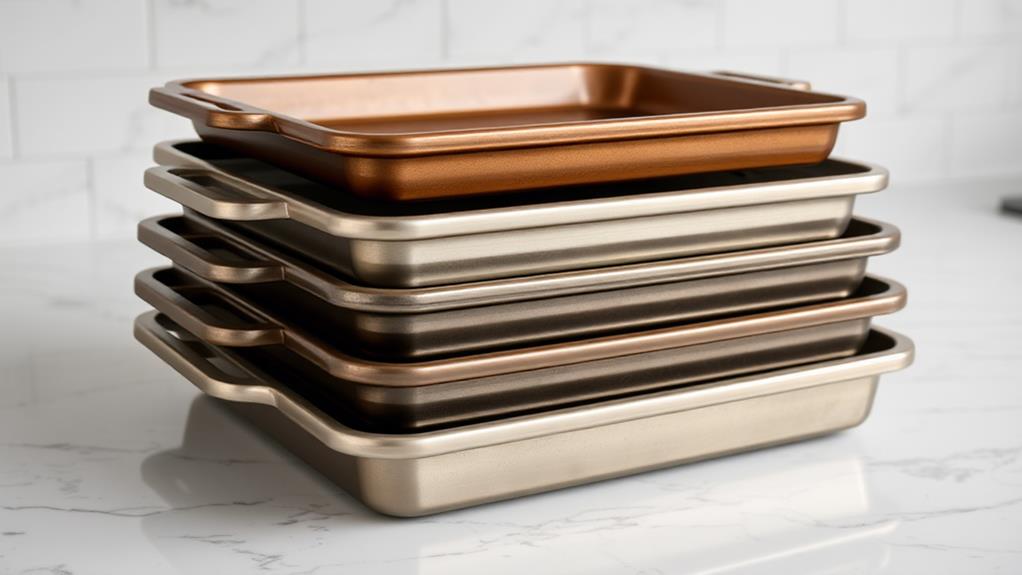
Delving into sheet pan materials and durability reveals a world of options for home cooks and professional chefs alike. When choosing a sheet pan, you'll encounter three primary materials: aluminum, aluminized steel, and stainless steel. Each offers unique benefits for your baking needs. Aluminum sheet pans, such as the Nordic Ware Naturals Quarter Sheet, are popular due to their excellent heat conduction, ensuring even baking results. The Nordic Ware pans are also resistant to rust and are ideal for high-temperature baking. However, they may warp over time with heavy use. Aluminized steel pans combine the benefits of aluminum and steel, offering durability and resistance to bending. For long-lasting performance, stainless steel sheet pans are your best bet, as they're highly durable and rust-resistant.
Consider these factors when selecting your sheet pan material:
- Heat conductivity
- Resistance to warping
- Ease of cleaning
- Compatibility with your cooking style
Some sheet pans come with nonstick coatings, which can be a game-changer for easy food release and cleanup. However, be cautious with metal utensils, as they can scratch the surface. Ultimately, your choice of sheet pan material will impact your baking results, maintenance requirements, and overall kitchen experience. By understanding these materials' properties, you'll be better equipped to select the perfect sheet pan for your culinary adventures.
Industry Applications for Sheet Pans
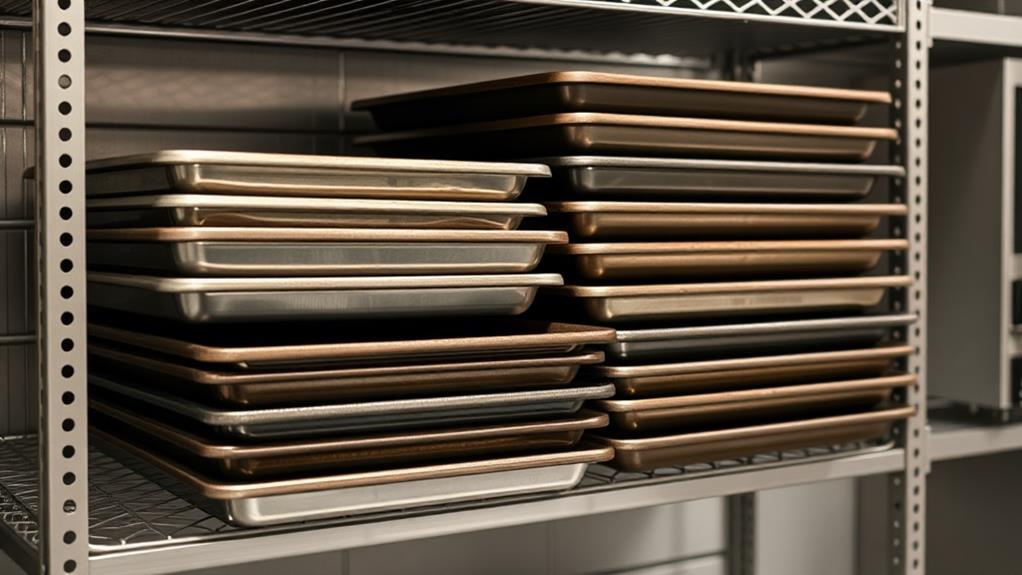
In the bustling world of professional kitchens, sheet pans are indispensable workhorses. You'll find full-size pans measuring 26 x 18 inches dominating commercial kitchens, maximizing cooking surface area for bulk food preparation. These aluminum pans are vital for high-volume baking and roasting tasks.
When you're working in institutional settings, half-sheet pans become your go-to tool. At 18 x 13 inches, they're perfect for cookie baking and vegetable roasting. You can fit two of these on a standard oven shelf, optimizing your cooking efficiency.
For smaller operations like food trucks, quarter-sheet pans (13 x 9 inches) are invaluable. They're ideal for batch cooking and organizing ingredients in tight spaces. If you're specializing in desserts, jelly roll pans (15.5 x 10.5 inches) are designed specifically for creating jelly rolls and bar cookies.
The use of aluminum and aluminized steel in these pans guarantees even heat distribution, vital for consistent results in high-volume food service. Whether you're baking hundreds of cookies or roasting vegetables for a large event, these durable, heat-conductive pans are essential tools in your culinary arsenal.
Frequently Asked Questions
What Is a Standard Size Sheet Pan?
When you're looking for a standard size sheet pan, you'll typically find a full-size pan measuring 26 by 18 inches. This size is commonly used in commercial kitchens for high-volume baking. However, for home cooking, you might prefer a half-size sheet pan, which measures 18 by 13 inches. This more manageable size fits easily in most home ovens and is versatile for various recipes. Remember, sheet pan sizes can vary slightly between manufacturers, so always check the dimensions before purchasing.
What Is the Difference Between a Sheet Pan and a Cookie Sheet?
You'll notice key differences between sheet pans and cookie sheets. Sheet pans have raised edges on all sides, while cookie sheets typically have one raised edge for handling. Cookie sheets are designed specifically for baking cookies, offering better air circulation due to their flat surface. They often come in insulated versions to prevent burnt edges. Sheet pans, on the other hand, are more versatile, suitable for roasting vegetables and baking various items. Their sizes also differ, with sheet pans available in standard sizes like full, half, and quarter.
What Size Pan Is Best for Sheet Cake?
For fantastic, flavorful sheet cakes, you'll find that a half-sheet pan is your best bet. Measuring 18 by 13 inches, it's perfect for a single-layer cake that'll serve a crowd. If you're baking for a smaller group, consider a quarter-sheet pan (9 by 13 inches). For grand gatherings, go big with a full-sheet pan (26 by 18 inches). Remember, depth matters too – aim for about 1 inch to prevent overflow. Always match your pan size to your cake needs and guest count.
What Size Is a Hotel Sheet Pan?
A hotel sheet pan, also known as a full-size sheet pan, typically measures 18 x 26 inches. You'll find these pans have 1-inch high sides, perfect for containing liquids and preventing spills. They're made of durable materials like aluminum or stainless steel, making them ideal for commercial kitchens. You'll appreciate their large surface area, which allows for cooking bigger batches of food. The standardized dimensions guarantee they'll fit seamlessly into commercial ovens and warming cabinets.





